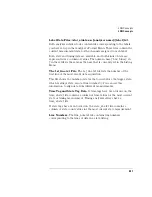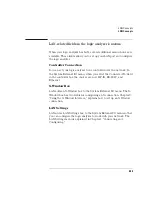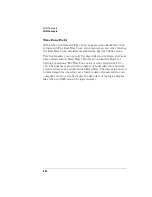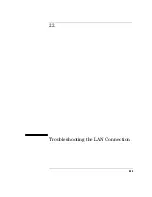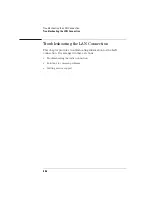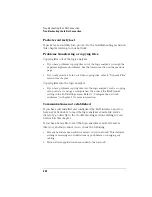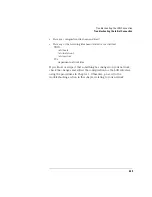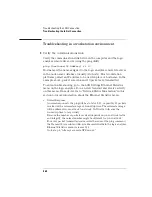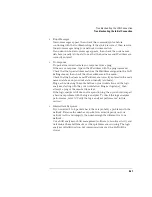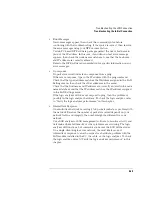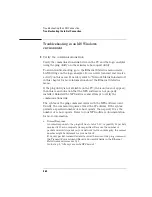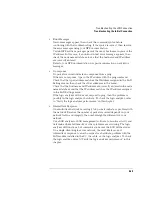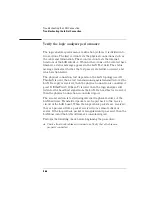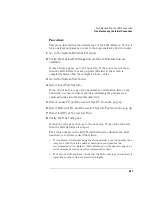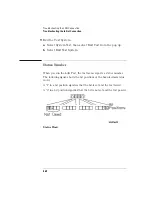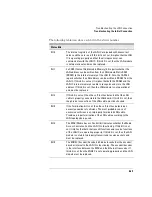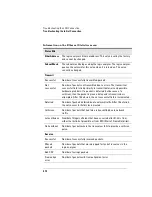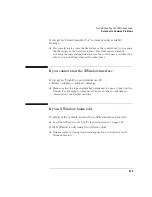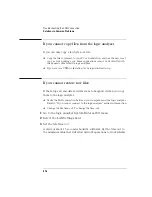
561
Troubleshooting the LAN Connection
Troubleshooting the Initial Connection
•
Error Messages
If error messages appear, then check the command syntax before
continuing with the troubleshooting. If the syntax is correct, then resolve
the error messages using your network documentation.
If an unknown host error message appears, then check the node names
database (usually /etc/hosts) to see that the hostname and IP address are
correctly entered.
•
No response
No packets received indicates no response from a ping.
If there is no response, type in the IP address with the ping command.
Check that the typed address matches the IPaddress assigned in the LAN
Settings menu, then check the other addresses in the menu.
Check that the hostname and IP address are correctly entered in the node
names database on your workstation (usually /etc/hosts).
Ping each node along the route between your workstation and the logic
analyzer, starting with the your workstation. Ping each gateway, then
attempt a ping of the remote file server.
If the logic analyzer still does not respond to ping, then you should suspect
a hardware problem with the logic analyzer. To check the logic analyzer
performance, refer to "Verify the logic analyzer performance" in this
section.
•
Intermittent Response
If you received 1 to 8 packets back, there is probably a problem with the
network. Because the number of packets received depends on your
network traffic and integrity, the number might be different for your
network.
Use a LAN analyzer or LAN management software to monitor activity and
determine where bottlenecks or other problems are occurring. The logic
analyzer will still function, but communications over the LAN will be
slower.
Summary of Contents for 1670E Series
Page 6: ...6 In This Book...
Page 26: ...26 Contents...
Page 27: ...27 Section 1 Logic Analyzer...
Page 28: ...28...
Page 29: ...29 1 Logic Analyzer Overview...
Page 39: ...39 2 Connecting Peripherals...
Page 49: ...49 3 Using the Logic Analyzer...
Page 72: ...72 Using the Logic Analyzer The Inverse Assembler...
Page 73: ...73 4 Using the Trigger Menu...
Page 101: ...101 5 Using the Oscilloscope...
Page 151: ...151 6 Using the Pattern Generator...
Page 199: ...199 7 Triggering Examples...
Page 237: ...237 8 File Management...
Page 249: ...249 9 Logic Analyzer Reference...
Page 360: ...360 Logic Analyzer Reference The Compare Menu...
Page 361: ...361 10 System Performance Analysis SPA Software...
Page 397: ...397 11 Logic Analyzer Concepts...
Page 430: ...430 Logic Analyzer Concepts The Analyzer Hardware Oscilloscope board theory Oscilloscope board...
Page 439: ...439 12 Troubleshooting the Logic Analyzer...
Page 455: ...455 13 Specifications...
Page 471: ...471 14 Operator s Service...
Page 479: ...479 Operator s Service Troubleshooting Troubleshooting Flowchart 2...
Page 491: ...491 Section 2 LAN...
Page 492: ...492...
Page 493: ...493 15 Introducing the LAN Interface...
Page 497: ...497 16 Connecting and Configuring the LAN...
Page 506: ...506 Connecting and Configuring the LAN Connecting and Configuring the LAN...
Page 507: ...507 17 Accessing the Logic Analyzer File System Using the LAN...
Page 515: ...515 18 Using the LAN s X Window Interface...
Page 527: ...527 19 Retrieving and Restoring Data Using the LAN...
Page 539: ...539 20 Programming the Logic Analyzer Using the LAN...
Page 546: ...546 Programming the Logic Analyzer Using the LAN Programming the Logic Analyzer Using the LAN...
Page 547: ...547 21 LAN Concepts...
Page 555: ...555 22 Troubleshooting the LAN Connection...
Page 580: ...580 Troubleshooting the LAN Connection Getting Service Support...
Page 581: ...581 Section 3 Symbol Utility...
Page 582: ...582...
Page 583: ...583 23 Symbol Utility Introduction...
Page 588: ...588 Symbol Utility Introduction Symbol Utility Introduction...
Page 589: ...589 24 Getting Started with the Symbol Utility...
Page 597: ...597 25 Using the Symbol Utility...
Page 609: ...609 26 Symbol Utility Features and Functions...





